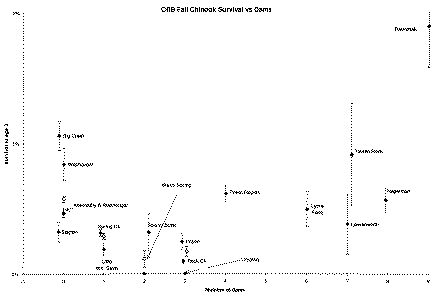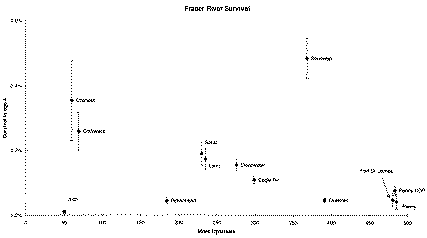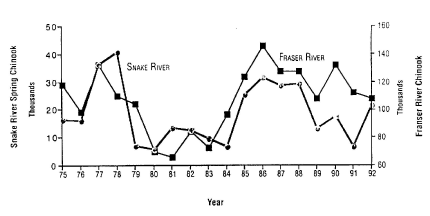![]()
Dams low enough to have fish ladders are fundamentally similar to a natural obstacle in the river, like a waterfall or rapids. The balance of this Chapter focuses on that sort of dam. All of the eight dams that form the backbone of the Federal Columbia River Power System, situated on the mainstem Columbia and Snake Rivers, do have fish ladders and are entirely passable to fish.
Few people look beyond the Columbia and Snake Rivers and compare the decline of salmon in other, undammed rivers to assess the effect of the dams. The fishery agencies will not do this because if you look outside the Columbia River Basin (and even in it, on tributaries without dams), you will immediately begin to wonder if the dams cause any measurable problem with salmon production.
One run of sockeye, which ascends the Columbia River to Lake Okanogan, has not declined significantly even though that run must pass nine dams.33 (Scientists have suggested that the reason these sockeye have not declined, while the Snake River sockeye have, is because large populations of hatchery fish in the Snake River basin “may interact in negative ways with Snake River sockeye”.34) The American Fisheries Society recently released a study showing that more than 140 salmon runs in British Columbia are already extinct, almost none of which have any contact with dams.35
In the Columbia River, lower river coho salmon populations dropped sharply, to the extent that the National Marine Fisheries Service considered whether to list them as endangered. In 1993, the Service refused to do so, on the ground that they were extinct. The Service made this decision even though an analysis of coho scales suggested that wild populations continued to spawn,36 and expert geneticists testified that that the coho were not extinct.
As one writer documented, the decision not to list the coho “looked [to environmentalist Bill Bakke] like maybe the agency had dropped the lower river coho so it could keep the public’s attention focused on the faults of the hydropower system. The upriver chinook were best for making that case.”37 That was also what my boss, Jeff Ring, my co-worker, Gary Firestone, and I believed. At Jeff Ring’s urging, our clients had filed formal comments with the Service urging it to list the lower river coho as endangered. As things turned out, the decision not to list the coho was a spectacular success for the Service, as the public’s attention focused almost exclusively on the dams.
Another way to compare survival in undammed and dammed rivers is even more direct: comparing survival per mile in the upriver, undammed reaches, with the lower river, dammed reaches. Dr. McNeil prepared survival rates per mile for stream-type chinook salmon and steelhead using data collected since the 1960s for other purposes. The results: “survival does not differ greatly between dammed and undammed reaches . . .”38 Dr. McNeil attempted to correlate the survival per mile with the fraction of the reach that was dammed and obtained a result “suggesting that there is little or no correlation between the two variables”.39
His cautious conclusion: if the findings stood up to additional testing, “man-induced incremental mortality caused by dams would be of a low magnitude”.40 A less cautious conclusion would be that when we try and measure the effect of the dams, it is so small as to be undetectable.
Dr. McNeil’s study does not account for the fact that the undammed reaches were higher up in the river, where juvenile salmon are younger and may die at a higher rate per day. Generally speaking, in most species there is greater “culling” of the population in the earliest life phases. But no one has tried to figure out the extent to which that could explain Dr. McNeil’s result.
Yet another way to look at the total effect of dams is to compare the survival of hatchery salmon from upstream and downstream hatcheries. If river mortality were a major problem, one would expect to see a big difference in the survival of upriver and downriver fish.
Professor Ray Hilborn of the University of Washington studied hatcheries in the Columbia River Basin, and made a remarkable discovery: the effectiveness of a fall chinook hatchery is entirely independent of its distance from the ocean—and the number of dams the fall chinook had to traverse. Here is his data on the percentage of adult fall chinook returns from fall chinook hatcheries in the Columbia River Basin:

Figure 7: Effectiveness of Fall Chinook Hatcheries vs. Number of Dams
Reviewing these results, Professor Hilborn offered three hypotheses: “(1) there is a trend in hatchery productivity that increases as we move upstream which masks the effect of downstream passage loss, (2) the barge transportation system has been effective at reducing downstream loss so that any remaining loss is masked by the noise in the data, [or] (3) the detailed studies of dam passage loss . . . have overestimated the loss.”41 While it is always possible that upriver hatcheries, which may use different stocks of salmon, are more effective, the most reasonable explanation is that dam mortality is small and perhaps reduced to an invisible level by transportation.
It is especially noteworthy that fall chinook survival does not seem to depend on the number of dams because juvenile fall chinook salmon tend to slip through bypass systems and go through turbines more than juvenile spring chinook salmon.
Professor Hilborn did not find the same results for spring chinook salmon hatcheries. The data suggest that the effectiveness of hatcheries raising spring chinook declines as the hatcheries get further upriver.

Figure 8: Effectiveness of Spring Chinook Hatcheries vs. Distance Upriver
But just because survival from upriver hatcheries decreases with the number of dams does not mean the effect is related to dams. It could be related to distance, with or without dams. Professor Hilborn decided to see how spring chinook hatcheries performed going up the Fraser River in Canada, which is not dammed. The results:

Figure 9: Effectiveness of Fraser River Spring Chinook Hatcheries vs. Distance Upriver
Generally speaking, the spring chinook hatcheries are less effective upriver whether there are dams or not. As Dr. Hilborn noted, “[i]f we accept the Fraser River as a reference ‘control’ on the dams of the Columbia, then we conclude that the decline in survival seen in hatchery spring/summer stocks as we move upriver may be largely due to the biology of cultured spring/summer [fish] rather than passage”.42
The National Research Council has noted that the Fraser River “shares many biogeoclimatic features” with the Columbia River, and that salmon catches in the Fraser tend “to show an abundance similar to that observed historically in the Columbia”, despite “the absence of dams on the mainstem Fraser River”.43 Here is a comparison:

Figure 10: Snake River vs. Fraser River Chinook Salmon Runs44
One would think that if the eight dams in the migration path of Snake River salmon had any ascertainable effect on salmon populations, there would be bigger differences in population trends than are evident here.
Dr. McNeil has also investigated ratios of “recruits to escapees” for both Columbia Basin and Canadian salmon stocks. When hatchery and wild fish are lumped together as a group, “[e]stimated ratios of recruits per escapee are similar for chinook and sockeye salmon in the Columbia Basin upstream from Bonneville Dam and in pristine rivers of British Columbia and Alaska”.45 Dr. McNeil thinks that this ratio is associated with carrying capacity and production limits, and that “[s]uccessful actions to increase abundance of wild fish may require concurrent reductions in hatchery fish”.46
The few scientists familiar with all this data perceive its significance. Dr. Gerald Bouck is a biologist who spent 33 years working for the U.S. Environmental Protection Agency, the U.S. Fish and Wildlife Service and the Fish and Wildlife Division of BPA. At the American Fisheries Society annual meeting in 1997, he received a lifetime achievement award for his work on preservation and protection of salmon. His conclusion: "Frankly, I believe that the Columbia River salmon runs most likely would have declined to their present condition even if no main-stem dams had been built."47 Dr. Doug Neeley, a biologist specializing in statistics and genetics, thinks that reduced survival through Columbia and Snake River dams “is not the major contributor of decline” for endangered Snake River salmon populations.48
No government agency has ever prepared a written explanation of the significance of Professor McNeil’s work, Professor Hilborn's work and all the other work that shows that the total effect of dams on salmon is small. Instead, the government agencies hold fast to data from the 1970s, when dams did injure salmon populations, and pretend that all the improvements since then never happened.
It is one of the principal ambitions of administrative law, having abandoned any effort to judge the wisdom of administrative decisions, to at least ensure that an administrative agency has considered all the relevant issues when making decisions. But for reasons explained in Chapter 9, the courts have so far refused even to rule on whether the government agencies must consider this body of scientific research.
33 G. Bouck, "Thirty years taught that money won't save salmon", The Oregonian, Oct. 20, 1995, at D7.
34 NRC, Upstream at 86 (Prepub. ed.).
35 Reported in T. Warner, “Expensive talk of dam removal”, The Wenatchee World, Oct. 18, 1996.
36 J. Cone, A Common Fate 157.
38 W. McNeil, “Survival of Marked Juvenile Chinook and Steelhead Migrants in the Columbia Basin”, Dec. 10, 1994, at 1.
41 R. Hilborn & C. Coronado, “Survival Trends in Columbia River hatchery chinook salmon”, at 4-5 (3/96 Draft Report). Dr. Hilborn offered a fourth hypothesis, that the data were too noisy to see the pattern, but rejected it because of the significant sample sizes involved.
44 HARZA Northwest, “Salmon Decision Analysis Lower Snake River Feasilbility Study: Final Report”, Oct. 4, 1996, at 3-4 (Figure 3-5).
45 W. McNeil, “Recruits per Escapee for Columbia Basin Anadromous Salmonids”, Dec. 5, 1994, at 1.
47 G. Bouck, "Thirty years taught that money won't save salmon", The Oregonian, Oct. 20, 1995, at D7.
48 Declaration of Doug Neeley, Feb.7, 1993, at 2, filed in IDFG v. NMFS, No. 93-1603-MA (D. Or.).
This Web page was created using a Trial Version of HTML Transit 3.0.